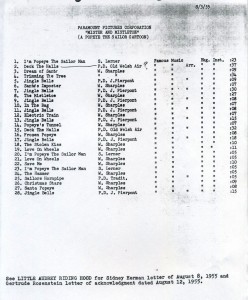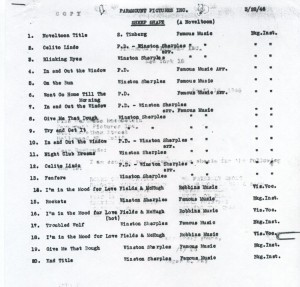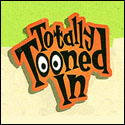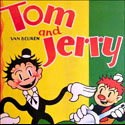
Cue Sheets are legally obligated paperwork that started at the dawn of sound motion pictures – and are still required for all motion pictures and television shows still today. This is how music rights organizations (ASCAP, BMI, etc.) and Hollywood studios (MGM, Paramount, etc.) keep track of music and songs in their films and programs, in order to compensate their composers.
This paperwork is done for all films – including theatrical and television cartoons. In addition to letting us know what the names of the songs used in the film, the cue sheet itself contains other bits of useful information. For example, the sheet above for Warner Bros. first Looney Tune, Sinkin’ In The Bathtub (1930) indicates a production number, the composers, and a date (June 21st) which can lead us to deduct when the music was finalized for this film.
Unfortunately, cue sheets aren’t readily accessible from all the studios – they aren’t made public. There are no books compiling this data. Dedicated animation researchers and music historians who sometimes land in the right place at the right time can occasionally copy this material for reference purposes. Here are a few that come from the collections of Piet Schreuders and myself – from Warner Bros., MGM, Fleischer and Famous Studios – and a pair of odd sheets from the early 1930s: one adding music to a Mutt & Jeff (1926) silent, and one (below) to a later (1927) Felix The Cat film:

Click on thumbnails below to enlarge and read:








 Jerry Beck is a writer, animation producer, college professor and author of more than 15 books on animation history. He is a former studio exec with Nickelodeon Movies and Disney, and has written for The Hollywood Reporter and Variety. He has curated cartoons for DVD and Blu-ray compilations and has lent his expertise to dozens of bonus documentaries and audio commentaries on such. Beck is currently on the faculty of CalArts in Valencia, UCLA in Westwood and Woodbury University in Burbank – teaching animation history. More about Jerry Beck [
Jerry Beck is a writer, animation producer, college professor and author of more than 15 books on animation history. He is a former studio exec with Nickelodeon Movies and Disney, and has written for The Hollywood Reporter and Variety. He has curated cartoons for DVD and Blu-ray compilations and has lent his expertise to dozens of bonus documentaries and audio commentaries on such. Beck is currently on the faculty of CalArts in Valencia, UCLA in Westwood and Woodbury University in Burbank – teaching animation history. More about Jerry Beck [








Just in case someone misinterprets these, cue sheets were usually prepared when the cartoon was completely finished, well after the cartoon’s soundtrack had been recorded. Just look at the date of Feb. 27, 1941 on the cue sheet for CRACKPOT QUAIL – twelve days after its release date.
Quirky, but interesting.
Interesting that even the original tunes by Carl Stalling (that is, a cue not based on an existing song) were given song names. Before seeing this, I would’ve assumed they would’ve just said a generic “[original music by Carl Stalling]” instead.
Unfortunately without easy access to these cue sheets, the main way us fans can identify a previously unknown song is if we happen to get lucky during a search for old timey music. That’s how I discovered the title card for “The Ducksters”; I just stumbled upon it one day while sampling Doris Day recordings.